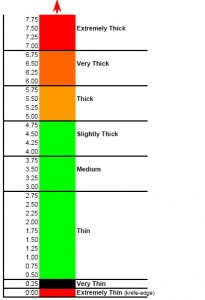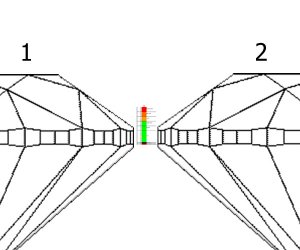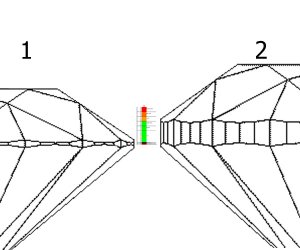I have been looking at RB ideal cut diamonds, and have noticed that the girdle size can differ between ideals. Which is better for a 6 prong solitare setting. I have noticed that a few of you have mentioned something about thin girdles being prone to chipping. Thanks again, the feedback has been awesome and I have learnt so much!
You are using an out of date browser. It may not display this or other websites correctly.
You should upgrade or use an alternative browser.
You should upgrade or use an alternative browser.
girdles?!
- Thread starter honey22
- Start date
- Status
- Not open for further replies. Please create a new topic or request for this thread to be opened.
:)
Brilliant_Rock
- Joined
- Jul 25, 2006
- Messages
- 1,864
I like medium for durability sake, however anything from thin to slightly thick can be okay (hopefully you will buy from a vendor you trust who can give you an explanation of any variations of the girdle if there are any). Generally avoid very thin (there was one exception demonstrated once on a princess where it was just I think a tiny spot of an indented natural, the rest of the stone was fine). Many here will tell you they like thin (and not medium) because then the weight of the diamond can go more towards the spread (=visual width) of the diamond - I am not sure if it really can make that much of a difference in visual spread of you took all of the spread that would go into a medium girdle and made a diamond with the same weight, angles, and a thin girdle. It would depend on the diamond I suppose, although I have noted in general terms that thin girdle diamonds *tend* to often have a bigger spread, but certainly not always.
ETA: thinner girdles are also more of an issue in shapes like princess cuts with the corners that can be more prone to chipping
ETA: thinner girdles are also more of an issue in shapes like princess cuts with the corners that can be more prone to chipping
Julianna
Brilliant_Rock
- Joined
- Mar 19, 2007
- Messages
- 528
mrssalvo
Super_Ideal_Rock
- Joined
- Jan 3, 2005
- Messages
- 19,132
- Joined
- Apr 22, 2004
- Messages
- 38,364
JohnQuixote
Ideal_Rock
- Joined
- Sep 9, 2004
- Messages
- 5,212
On a well-made diamond the girdle will have enough thickness to prevent chipping but no so much that it adds weight needlessly.
If the description = thin, med, slightly thick (or any combo of the three) it meets the above criteria for AGSL/GIA.If one descriptor is outside (vtn-med for example) don’t panic. Further examination of the specific diamond will reveal what the ‘outer’ descriptor implies.It may be enough to disqualify it, or it could be a single position that won't be a problem.It’s a stone by stone call.
Thin, med & slightly thick girdles are all durable and hide no appreciable weight. We suggest the med or stk range for tension settings. A girdle at the thin side of thin gets you a tiny bit more spread.
Remember girdle thickess is a range: One girdle described as “thin” may be a micron away from medium.Another “thin” may be close to very thin.Both are perfectly acceptable, but the hair-from-medium "thin" would be a better candidate for certain settings. The AGSL range for thin is wider than the ranges for medium & slightly thick combined, so an abundance of well-made diamonds will have thin in their girdle description.
Here is a chart I used in a webinar some time ago.

If the description = thin, med, slightly thick (or any combo of the three) it meets the above criteria for AGSL/GIA.If one descriptor is outside (vtn-med for example) don’t panic. Further examination of the specific diamond will reveal what the ‘outer’ descriptor implies.It may be enough to disqualify it, or it could be a single position that won't be a problem.It’s a stone by stone call.
Thin, med & slightly thick girdles are all durable and hide no appreciable weight. We suggest the med or stk range for tension settings. A girdle at the thin side of thin gets you a tiny bit more spread.
Remember girdle thickess is a range: One girdle described as “thin” may be a micron away from medium.Another “thin” may be close to very thin.Both are perfectly acceptable, but the hair-from-medium "thin" would be a better candidate for certain settings. The AGSL range for thin is wider than the ranges for medium & slightly thick combined, so an abundance of well-made diamonds will have thin in their girdle description.
Here is a chart I used in a webinar some time ago.

JohnQuixote
Ideal_Rock
- Joined
- Sep 9, 2004
- Messages
- 5,212
JohnQuixote
Ideal_Rock
- Joined
- Sep 9, 2004
- Messages
- 5,212
JohnQuixote
Ideal_Rock
- Joined
- Sep 9, 2004
- Messages
- 5,212
JohnQuixote
Ideal_Rock
- Joined
- Sep 9, 2004
- Messages
- 5,212
JohnQuixote
Ideal_Rock
- Joined
- Sep 9, 2004
- Messages
- 5,212
You can investigate descriptors outside thin, med and stk. Here is a princess with a girdle described as very thin-med. Almost the entire girdle is medium.The vtn on the grading report referred to an indented natural on a corner (arrow).In this case the stonesetter was careful to protect the corner. No problems.

JohnQuixote
Ideal_Rock
- Joined
- Sep 9, 2004
- Messages
- 5,212
JohnQuixote
Ideal_Rock
- Joined
- Sep 9, 2004
- Messages
- 5,212
While putting these thoughts down, here are some on girdle finishing:
A faceted girdle is one where the brillianteer polished facets into the diamond's girdle.
An unfaceted, or bruted girdle (aka frosted) is one where the diamond's girdle remains unpolished and has a rough/frosted appearance. Some cutters believe polishing the girdle can cause color to be reflected back inside, so bruted girdles are more common in low near-colorless grades and down, and in small goods, 0.25 and lower. In top near-colorless diamonds it's not the concern that it is with slightly colored and below.
A polished girdle on a diamond is see-through or clear. This is sometimes considered a finishing touch but is not critical. One situation where polish is desirable is when the diamond is a fish-eye, where polishing will reduce the effect of the girdle's reflection in the table.
Some of today's girdling machines are putting a very fine texture on. These girdles are more than bruted but less than polished. We choose to call them finely finished: Not faceted, not completely polished, nor bruted. They're in a cozy place somewhere in-between.
A faceted girdle is one where the brillianteer polished facets into the diamond's girdle.
An unfaceted, or bruted girdle (aka frosted) is one where the diamond's girdle remains unpolished and has a rough/frosted appearance. Some cutters believe polishing the girdle can cause color to be reflected back inside, so bruted girdles are more common in low near-colorless grades and down, and in small goods, 0.25 and lower. In top near-colorless diamonds it's not the concern that it is with slightly colored and below.
A polished girdle on a diamond is see-through or clear. This is sometimes considered a finishing touch but is not critical. One situation where polish is desirable is when the diamond is a fish-eye, where polishing will reduce the effect of the girdle's reflection in the table.
Some of today's girdling machines are putting a very fine texture on. These girdles are more than bruted but less than polished. We choose to call them finely finished: Not faceted, not completely polished, nor bruted. They're in a cozy place somewhere in-between.
- Joined
- Apr 30, 2005
- Messages
- 42,064
sugarplum
Brilliant_Rock
- Joined
- Jun 11, 2007
- Messages
- 693
risingsun
Ideal_Rock
- Joined
- Dec 19, 2006
- Messages
- 5,549
Richard Sherwood
Ideal_Rock
- Joined
- Sep 25, 2002
- Messages
- 4,924
strmrdr
Super_Ideal_Rock
- Joined
- Nov 1, 2003
- Messages
- 23,295
- Status
- Not open for further replies. Please create a new topic or request for this thread to be opened.












300x240.png)